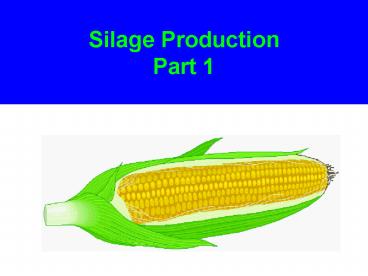Silage Production Part 1 - PowerPoint PPT Presentation
1 / 25
Title:
Silage Production Part 1
Description:
Both hay and silage production are important components in forage livestock ... One of the main advantages of making silage is that unlike hay production, ... – PowerPoint PPT presentation
Number of Views:10527
Avg rating:3.0/5.0
Title: Silage Production Part 1
1
Silage ProductionPart 1
2
- One of the main reasons for producing forage
crops is to produce feed for ruminant animals
3
- Some of the feed is available through grazing,
and this provides a way to provide forages to
animals at a low cost
4
- However, major portions of the forages produced
in the U.S. and abroad are stored as conserved
forages, which include hay and silages.
5
- Both hay and silage production are important
components in forage livestock systems, and both
have particular advantages and disadvantages.
6
- One of the main advantages of making silage is
that unlike hay production, field drying is
essentially eliminated - In addition, raking and baling are not required
7
- When conditions are not favorable for making hay,
silage making can provide a sensible and
profitable alternative crop.
8
What is silage?
- Chopped, fresh plant material that has been
preserved by a process of fermentation (ensiling)
in which organic acids are formed, particularly
lactic acid.
9
- The resulting acidity prevents unfavorable
microbes from developing on the material and
causing it to spoil.
10
- Silage is sometimes classified in three ways by
moisture content - Haylage - 40-60 moisture
- Wilted Silage - 60-75 moisture
- Direct cut - 75-90 moisture
11
- Advantages of producing silage instead of hay
would include - more nutrients are preserved
- shorter drying time
- flexibility in harvesting (rain damage not as
critical
12
- Potential disadvantages would include
- Not easily transportable like hay bales
- May need to invest in special storage structures
such as upright silos
13
- Potential disadvantages would include
- If improperly stored, losses will be high
14
- Silage may be made from essentially any
vegetative materials but it works best if the
materials to be ensiled contain an abundance of
sugars that are easily fermented
15
- Good quality silage is commonly made from
alfalfa, forage grasses, and small grains
16
- Grain crops such as corn and sorghum make
especially good silage because the grain provides
sugars for rapid fermentation
17
- Making corn silage is in one sense a relatively
new practice. One of the earliest attempts to
ensile corn was made in Germany in 1861. The
first American silo was built in Maryland in
1876.
18
- Recent estimates suggest that approximately 10
of the corn acreage in the U.S. is harvested for
silage. - The major region of silage production in the U.S.
consists of the so called dairy states of
Wisconsin, Minnesota, and Michigan
19
- A number of different structures are used to make
and store silage. Silage is stored vertically in
upright silos or tower silos.
20
- Silos constructed horizontally either in or on
the soil surface are known as trench silos or
bunker silos.
21
- A relatively new innovation known as silage bags
or ag bags have been developed. - This has become a popular approach since it does
not require construction or maintenance of a
typical upright or bunker silo.
22
- Upright silos have been constructed of wood or
reinforced concrete in the past. Newer silos
tend to be built of concrete blocks or glass
lined steel.
23
- One of the reasons that silage has become an
important option in conserved forages is because
it's feeding can be virtually entirely
mechanized. - Upright silos can be equipped with silo unloaders.
24
- Feed unloaded from the silo can then be
transported by an augur directly to feed bunks
for animal consumption
25
End































